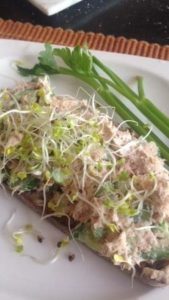Kitchen Shrink: It’s a Dilly! All-Purpose Pickle Primer
By:Catharine Kaufman
Salmon and Gherkin Salad with Pickles (Courtesy)
KITCHEN SHRINK:
Pickles of all manners are so beloved throughout the lands, they’ve been celebrated every May since 1948 during International Pickle Week, as diverse cultures pay tribute to their own version of the probiotic powerhouse. As summer swells into full bloom, it’s time to pick a peck of pickled pickles to enliven everything from burgers and brats to lobster rolls, assorted salads and ice cream (for pregnant cravings, of course) to suit sour, sweet, tangy and spicy palates.
Pickling is one of the oldest methods of food preservation tracing back 5,000 years when Mesopotamians soaked vegetables and fruits in a briny bath of salt, vinegar, herbs and spices until they nicely fermented. A few centuries later once the cucumber was cultivated in India and then pickled in the Tigris Valley its popularity soon trickled throughout ancient societies. In Egypt Cleopatra attributed her beauty and sex appeal to incorporating the sassy sour cuke into her diet.
From Julius Caesar to Christopher Columbus, both emperor and explorer believed that pickles had super powers to fortify soldiers and ward off scurvy in sailors. Eastern European Jews dialed up their bland diet with fermented cabbage, beets and cucumbers, sealed in barrels, and stored in cellars for use throughout the winter. During the wave of immigration to the United States settlers brought kosher dills to the Big Apple, along with the method of fermentation in wooden barrels using kosher salt, fresh dill, garlic and spices, where they were sold straight out of these vessels at Jewish delis.
Not all pickles are created equal depending on the species of cucumber, length of fermentation, type of brining vessel, amalgamation of pickling spices, (allspice, bay leaves, peppercorns, dill and mustard seeds, cardamom, juniper berries, crushed hot peppers), and international flavorings (soy sauce, curry, wasabi, sriracha, Cajun) used.
How a pickle is sliced is a matter of personal preference, whether lengthwise or crosswise (pickle chips), cut in waffles, spears, cubes, sticks, halves, diced, or eaten whole.
Twenty billion pickles are consumed every year in this country, the dill the most popular brined in a mixture of vinegar, salt, fresh dill or dill oil, and fermented until it becomes a lip-puckeringly sour, soggy, jade green delight. The half-sour dills are crisp, bright green pickles due to their short fermentation period in a vinegar-less brine with reduced salt, refrigerated throughout the process. Kosher-style dills are brined in kosher salt, along with plenty of dill and garlic, giving them a flavor oomph compared to traditional dills. The Polish-style dill is similar to the kosher dill, but is cured in a salty brine without vinegar, along with a load of garlic, while the German-style dill is pickled only in vinegar and lemon juice.
Southern parts have not only contributed the deep-fried pickle, but also the Kool-Aid pickle, known as the Koolickle. After soaking a dill in a bath of Kool-Aid and sugar for days, this sweet and sour pickle glows in electric hues of blue, red or orange. For a healthier riff try natural food coloring along with stevia or coconut sugar.
Sweet tooths might also indulge in tangy bread and butter pickles brined in a sugary vinegar base, usually pickled with onions and bell peppers, and cut into coins with ridged edges.
Diminutive “cornichons,” French for “gherkins” are either garden cucumbers harvested when they’re only a couple of inches long, or the naturally smaller West Indian or Burr species then fermented in a blend of wine vinegar and garlic, usually paired with pearl onions. These sweet, tangy petites make an ideal sandwich or cocktail garnish.
“Tsukemono,” which translates to “pickled things,” is the Japanese rendition with a blend of cucumbers, daikon radishes, turnips and plums pickled in miso paste, rice bran or sake creating colorful little snacking gems. While relish is a condiment of minced sweet pickles straight up or mixed with mustard to top sausages, dogs or burgers with an added crunch and flavor.
Cook’s Tip: Save pickle juice to add a zing to salad dressings, marinades, Dirty Martinis, or freeze in ice cube trays to use in other savory drinks.
The multi-purpose pickle can be wrapped in bacon, sliced on sandwiches, incorporated into sushi rolls, minced and tossed in chilled soups, Tzatziki dips, seafood cocktails, crab cakes, Cobb, egg, macaroni or redskin potato salads, or this delightful salmon mousse to stuff into hollows of heirloom tomatoes, avocado halves or spread on your favorite bread.


